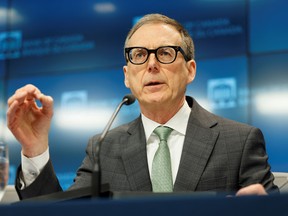Will interest rates soon follow inflation lower?
Article content
The inflation story starts a new chapter this week.
Advertisement 2
Article content
For the better part of a year, the narrative was one of consumer angst amid the worst inflation in forty years, and a central bank’s mission to crush price pressures with a staggering number of interest rate increases.
Article content
More recently, the pace of inflation has come off its peak, so much so that the Bank of Canada has paused its rate hikes for the time being. Statistics Canada likely will reveal more good news on April 18, when it likely will report that year-over-year increases in the consumer price index dropped to their lowest since at least the fall of 2021 in March.
Article content
Does that mean interest rates will soon follow inflation lower? It’s not that simple. Here’s what you need to know:
The good: Inflation is slowing
Quick recap: Year-over-year increases in the consumer price index — the conventional definition of inflation — peaked at 8.1 per cent peak in June, drifted to about seven per cent for a while, and then plunged to 5.2 per cent in February. This is a promising sign, but it’s too soon to celebrate, Bank of Canada governor Tiff Macklem said last week.
Advertisement 3
Article content
“The economy is still in excess demand, and so right now it’s still putting upward pressure on services prices,” Macklem told reporters on a conference call from Washington on April 14, a couple of days after the central bank opted to leave the benchmark interest rate at 4.5 per cent. “The downward pressure is modest, so it takes some time to get all the way back to the two per cent target.”
The Bank of Canada’s new economic outlook predicts the inflation mission will be accomplished by the end of 2024, which is how long policymakers think it will take to get inflation back to their target of two per cent. But they think it’s going to start to feel better much sooner than that. The central bank predicts to average 3.3 per cent this quarter, and slow to 2.5 per cent by the end of the year. That still would be faster than what Macklem thinks is good for the economy, but numbers that begin with “three” and “two” would be less stressful.
Article content
Advertisement 4
Article content
Royal Bank of Canada’s economics team estimates that the headline inflation slowed to 4.1 per cent in March, which would be the lowest pace of headline inflation since August 2021. Economists Claire Fan and Nathan Janzen pointed to lower gasoline prices as the main reason price pressures are cooling. They also expect that food inflation, which increased 9.7 per cent year-over-year gain in February, will also begin to ease.

The bad: Rates will stay high
Getting inflation under control meant bringing about a series of outsized rate hikes last year, highlighted by a full percentage point increase in July. In all, the Bank of Canada cranked up borrowing costs all the way to 4.5 per cent from 0.25 per cent in the span of a year. It’s a shift that everyone will have to grow accustomed to with rates expected to stay higher for longer. That’s because Macklem predicts getting inflation to two per cent from around three per cent will require some effort.
Advertisement 5
Article content
“Households, businesses, governments have to adjust to higher interest rates and so does the financial system,” Macklem said. “It can be difficult for Canadians to adjust to higher interest rates, it can also be difficult for the financial system.”

Still, the central bank wants to avoid overshooting and sending the economy into a recession. The Bank of Canada now forecasts that the economy won’t slow as dramatically as it thought possible in January, with the gross domestic product expected to expand 1.4 per cent this year, compared with a previous estimate of one per cent. That’s not great, but some economists say it looks like Macklem managed a “soft landing.”
However, stronger growth means the Bank of Canada will be focused solely on getting inflation back to the two per cent. That means interest rates likely will stay at current levels for an extended period, and Macklem said last week that further hikes are possible if inflation proves to be sticky.
Advertisement 6
Article content
The ugly: The legacy of SVB
The Silicon Valley Bank collapse is an example of the markets adage of “hiking until something breaks.” Regulators jumped in and stopped the contagion, however the episode was a sobering reminder of why central bankers were wary of raising interest rates too quickly after an extended period of near-zero borrowing costs.

Macklem said from Washington that central banks are focused on getting inflation back to target, but that they need to take financial stability into account. Macklem also pointed out some of the lessons central banks and the International Monetary Fund took away from the crisis, including the speed at which deposits fled SVB in the digital age.
It all means central bankers have something else to think about as they try to manage inflation. This may prompt regulators to have another look at their playbook and assess how deposit run-off assumptions could build into liquidity buffers – or the amount of cash banks are expected to have on hand to keep themselves afloat if customers quickly withdraw cash.
Advertisement 7
Article content
Bottom line: It’s complicated
When it comes to interest rates, what the central bank is saying and what the markets are pricing are different. Macklem’s message is that interest rates have probably peaked, but if anything, they could go higher before they go lower. Some investors and analysts disagree, as the price of assets tied to short-term interest rates telegraph rate cuts by the end of the year.
Macklem pushed back against such assumptions. “Building in cuts later in the year to us doesn’t look like the most likely scenario,” he said in Washington.
The governor said communication disconnects can happen for different reasons, including simple disagreement over the signals being sent by the data. “If there’s difference of opinion there, as new data comes out, it’s going to get resolved in one direction or the other,” Macklem said.
Advertisement 8
Article content
-

Interest rate shock is hitting Canadian homeowners
-

Interest rate shock is hitting Canadian homeowners
-

3 things the Bank of Canada told us at its press conference
However, if the disconnect is the result of a failure to communicate, Macklem said the central bank bears the responsibility of making sure those watching rate decisions and digging through its reports aren’t left with surprises. He added that the central bank goes out of its way with projections and now with summaries of deliberations to give more insight into what central bank members are thinking.
“We believe that monetary policy works better when people understand what we’re thinking,” Macklem said. “So, if that’s what’s causing the difference, certainly it’s on us to try and make sure that we’re as clear as we can be.”
• Email: shughes@postmedia.com | Twitter: StephHughes95
Inflation: What you need to know about March data
2023-04-17 15:02:35







Comments
Postmedia is committed to maintaining a lively but civil forum for discussion and encourage all readers to share their views on our articles. Comments may take up to an hour for moderation before appearing on the site. We ask you to keep your comments relevant and respectful. We have enabled email notifications—you will now receive an email if you receive a reply to your comment, there is an update to a comment thread you follow or if a user you follow comments. Visit our Community Guidelines for more information and details on how to adjust your email settings.
Join the Conversation